11.09.2020
Where Rocks Come Alive: OSIRIS-REx Observes an Asteroid in Action
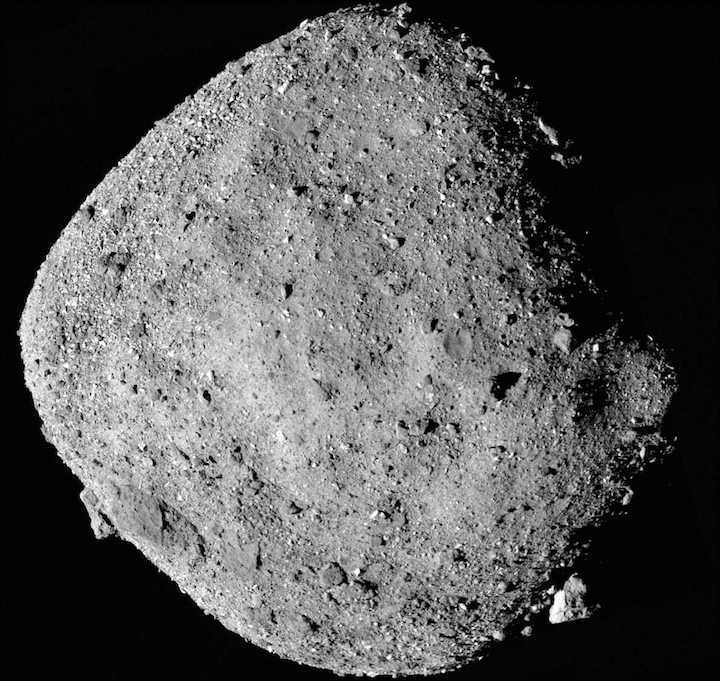
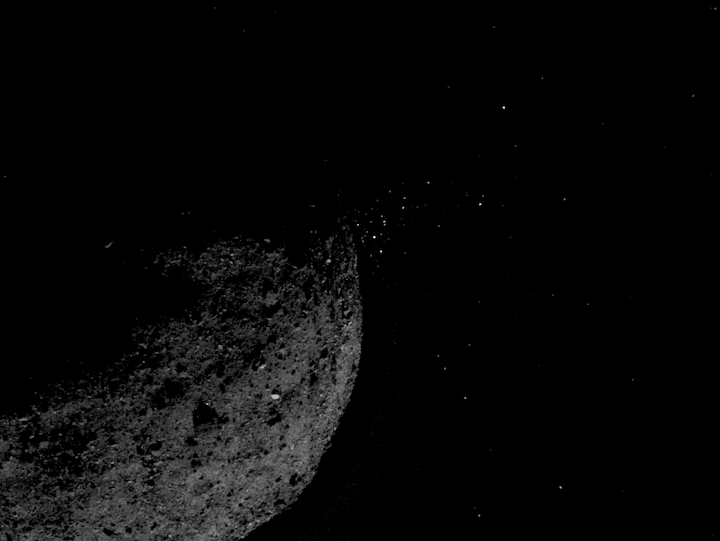
It's 5 o'clock somewhere. And while here on Earth, "happy hour" is commonly associated with winding down and the optional cold beverage, that's when things get going on Bennu, the destination asteroid of the University of Arizona-led OSIRIS-REx NASA mission.
In a special collection of research papers published today in the Journal of Geophysical Research: Planets, the OSIRIS-REx science team reports detailed observations that reveal Bennu is shedding material on a regular basis, most often during Bennu's local two-hour afternoon and evening timeframe.
The OSIRIS-REx spacecraft has provided planetary scientists with the opportunity to observe such activity at close range for the first time ever, and Bennu's active surface underscores an emerging picture in which asteroids are quite dynamic worlds.
The publications provide the first in-depth look at the nature of Bennu's particle ejection events, detail the methods used to study these phenomena, and discuss the likely mechanisms that cause the asteroid to release pieces of itself into space.
The OSIRIS-REx spacecraft will grab a sample from the surface of Bennu in October and return it to Earth on Sept. 24, 2023. The first observation of particles popping off the asteroid's surface was made in January 2019, mere days after the spacecraft arrived at Bennu. This event may have gone completely unnoticed were it not for the keen eye of the mission's lead astronomer Carl Hergenrother, a scientist in the UArizona Lunar and Planetary Laboratory and one of the lead authors of the collection and its introductory paper.
Much like ocean-going explorers in centuries past, the OSIRIS-REx space probe relies on stars to fix its position in space and remain on course during its years-long voyage. A specialized navigation camera onboard the spacecraft takes repeat images of background stars. By cross-referencing the constellations the spacecraft "sees" with programmed star charts, and course corrections can be made as necessary.
Hergenrother was poring over these images that the spacecraft had beamed back to Earth when something caught his attention. The images showed the asteroid silhouetted against a black sky, dotted with many stars – except there seemed to be too many.
"I was looking at the star patterns in these images and thought, 'huh, I don't remember that star cluster,'" Hergenrother said. "I only noticed it because there were 200 dots of light where there should be about 10 stars. Other than that, it looked to be just a dense part of the sky."
A closer inspection and an application of image-processing techniques solved the mystery: The "star cluster" was, in fact, a cloud of tiny particles that had been ejected from the asteroid's surface. Follow-up observations made by the spacecraft revealed the telltale streaks typical of objects moving across the frame, setting them apart from the background stars that appear stationary due to their enormous distances.
"We thought that Bennu's boulder-covered surface was the wildcard discovery at the asteroid, but these particle events definitely surprised us," said Dante Lauretta, OSIRIS-REx principal investigator and professor in the UArizona Lunar and Planetary Laboratory. "We've spent the last year investigating Bennu's active surface, and it's provided us with a remarkable opportunity to expand our knowledge of how active asteroids behave."
Since arriving at the asteroid, the team has observed and tracked more than 300 particle ejection events on Bennu. According to the authors, some particles escape into space, others briefly orbit the asteroid, and most fall back onto its surface after being launched.
Using data collected by NASA’s OSIRIS-REx mission, this video animation shows the trajectories of particles after their emission from asteroid Bennu’s surface. The animation emphasizes the four largest particle ejection events detected at Bennu from December 2018 through September 2019. Additional particles, some with lifetimes of several days, that are not related to the ejections are also visible. (Credit: M. Brozovic/JPL/Caltech/NASA/University of Arizona)
The spacecraft is equipped with a sophisticated set of electronic eyes – the Touch-and-Go Camera Suite, or TAGCAMS. Although its primary purpose is to assist in spacecraft navigation, TAGCAMS has now been placed into active duty spotting any particles in the vicinity of the asteroid.
Using software algorithms developed at UArizona's Catalina Sky Survey, which specializes in discovering and tracking near-Earth asteroids by detecting their motion against background stars, the OSIRIS-REx team found the largest particles erupting from Bennu to be about 6 centimeters (2 inches) in diameter. Due to their small size and low velocities – like a shower of tiny pebbles in super slow motion – the mission team does not deem the particles a threat to the spacecraft.
"Space is so empty that even when the asteroid is throwing off hundreds of particles, as we have seen in some events, the chances of one of those hitting the spacecraft is extremely small, and even if that were to happen, the vast majority of them are not fast or large enough to cause damage," Hergenrother said.
During a number of observation campaigns between January and September 2019 dedicated to detecting and tracking mass ejected from the asteroid, a total of 668 particles were studied, with the vast majority measuring between 0.5 and 1 centimeters (0.2-0.4 inches) and moving at about 20 centimeters (8 inches) per second, about as fast – or slow – as a beetle scurrying across the ground. In one instance, a speedy outlier was clocked at about 3 meters (9.8 feet) per second.
On average, the authors observed one to two particles kicked up per day, with much of the material falling back onto the asteroid. Add to that the small particle sizes, and the mass loss becomes minimal, Hergenrother explained.
"To give you an idea, all of those 200 particles we observed during the first event after arrival would fit on a 4-inch by 4-inch tile," he said. "The fact that we can even see them is a testament to the capabilities of our cameras."
The authors investigated various mechanisms that could cause the phenomena, including released water vapor, impacts by small space rocks known as meteoroids and rocks cracking from thermal stress. The two latter mechanisms were found to be the most likely driving forces, confirming predictions about Bennu's environment based on ground observations preceding the space mission.
As Bennu completes one rotation about every four hours, boulders on its surface are exposed to a constant thermo-cycling as they heat during the day and cool during the night. Over time, the rocks crack and break down, and eventually particles may be thrown from the surface. The fact that particle ejections were observed with greater frequency during late afternoon, when the rocks heat up, suggests thermal cracking is a major driver. The timing of the events is also consistent with the timing of meteoroid impacts, indicating that these small impacts could be throwing material from the surface. Either, or both, of these processes could be driving the particle ejections, and because of the asteroid's microgravity environment, it doesn't take much energy to launch an object from Bennu's surface.
Of the particles the team observed, some had suborbital trajectories, keeping them aloft for a few hours before they settled back down, while others fly off the asteroid to go into their own orbits around the sun.
In one instance, the team tracked one particle as it circled the asteroid for almost a week. The spacecraft's cameras even witnessed a ricochet, according to Hergenrother.
"One particle came down, hit a boulder and went back into orbit," he said. "If Bennu has this kind of activity, then there is a good chance all asteroids do, and that is really exciting."
As Bennu unveils more of itself, the OSIRIS-REx team continues to discover that this small world is glowingly complex. These findings could serve as a cornerstone for future planetary missions that seek to better characterize and understand how these small bodies behave and evolve.
Quelle: University of Arizona
+++
SwRI-LED STUDY INDICATES SAND-SIZED METEOROIDS ARE PEPPERING ASTEROID BENNU
A new study in JGR Planets posits that the major particle ejections off the near-Earth asteroid Bennu may be the consequence of impacts by small, sand-sized particles called meteoroids onto its surface as the object nears the Sun. The study’s primary author is Southwest Research Institute scientist Dr. William Bottke, who used data from NASA’s OSIRIS-REx mission.
Launched in 2016, NASA’s OSIRIS-REx spacecraft is currently orbiting Bennu with the aim of briefly touching on the surface and obtaining a sample from the asteroid in October 2020, and then returning to Earth.
“While in orbit, the spacecraft has been sending images of Bennu back to Earth,” Bottke said. “One of the most significant things we’ve noticed is that the asteroid is frequently ejecting materials into space. Tiny rocks are just flying off its surface, yet there is no evidence that they are propelled by sublimating ice, as one might expect from a comet. The biggest events launch rocks as large as a few centimeters.”
Even more curious is the fact that the observed major ejection events tend to occur in the late afternoon on Bennu. Determined to get to the bottom of these events, Bottke reached out to Althea Moorhead at NASA’s Marshall Space Flight Center. Moorhead is a member of NASA’s Meteoroid Environment Office, a group that monitors and models meteoroids that may be hazardous to spacecraft.
“Over the years, Althea and her team have built a computer model that determines the number of tiny particles impacting spacecraft,” Bottke explained. “We used this software to calculate the number of meteoroid impacts Bennu would face in its current orbit.”
Many meteoroids originated on comets. As comets approach the Sun, pieces break off as a consequence of solar heating. Some comets even break apart, producing far more small particles than asteroid collisions in the asteroid belt. For this reason, comet fragments are thought to be the major source of meteoroids that fill the inner solar system.
Interpreting their modeling results, Bottke’s study suggests that as Bennu draws closer to the Sun in its orbit, it experiences a higher number of meteoroid impacts. Moreover, sand-sized meteoroids are predicted to hit Bennu with the force of a shotgun blast about once every two weeks, with most striking in the head-on direction. Their impact location on Bennu corresponds to late afternoon and early evening.
Furthermore, Bottke’s study points out that the Lunar Atmosphere and Dust Environment Explorer (LADEE) previously made similar observations about impacts on the Moon. As with Bennu, most meteoroids hit the Moon head-on (with head-on defined with respect to the motion of the Earth-Moon system around the Sun). The key difference between Bennu and the Moon is how they rotate around their spin axes. The Moon spins west to east, so head-on impacts correspond to sunrise. Bennu spins in the opposite direction, so head-on impacts hit near dusk.
At first, Bottke’s modeling work seem to predict that meteoroids would eject too little material from Bennu to explain the OSIRIS-REx observations. However, a better match could be obtained if Bennu has a weak porous surface. The possibility that Bennu has this property was recently strengthened by studies of the Bennu-like asteroid Ryugu, the target of Japan’s Hayabusa2 sample return mission. Using explosives to launch a small projectile into Ryugu, the Hayabusa2 team produced a crater that was larger than expected by most impact experts. If Bennu’s surface is indeed similar to Ryugu’s, meteoroid impacts should be capable of ejecting relatively large amounts of debris.
The OSIRIS-REx mission is led by the University of Arizona. NASA’s Goddard Space Flight Center provides overall mission management and Lockheed Martin Space built the spacecraft and executes flight operations. OSIRIS-REx is a New Frontiers Program mission, administered by the Marshall Space Flight Center in Huntsville, Alabama, for NASA’s Science Mission Directorate.
Quelle: Southwest Research Institute
----
Update: 22.09.2020
.
NASA’s OSIRIS-REx to Asteroid Bennu: “You’ve got a little Vesta on you…”
In an interplanetary faux pas, it appears some pieces of asteroid Vesta ended up on asteroid Bennu, according to observations from NASA’s OSIRIS-REx spacecraft. The new result sheds light on the intricate orbital dance of asteroids and on the violent origin of Bennu, which is a “rubble pile” asteroid that coalesced from the fragments of a massive collision.
“We found six boulders ranging in size from 5 to 14 feet (about 1.5 to 4.3 meters) scattered across Bennu’s southern hemisphere and near the equator,” said Daniella DellaGiustina of the Lunar & Planetary Laboratory, University of Arizona, Tucson. “These boulders are much brighter than the rest of Bennu and match material from Vesta.”
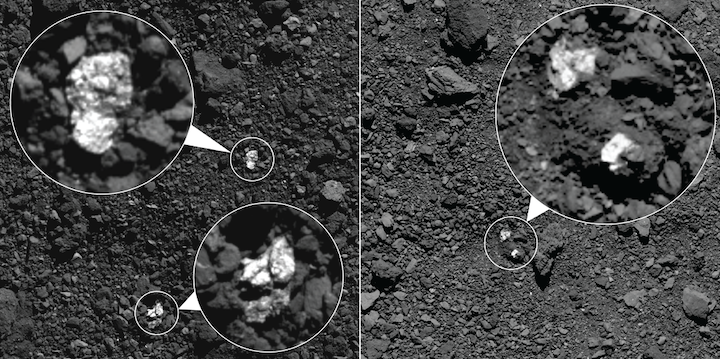
“Our leading hypothesis is that Bennu inherited this material from its parent asteroid after a vestoid (a fragment from Vesta) struck the parent,” said Hannah Kaplan of NASA’s Goddard Space Flight Center in Greenbelt, Maryland. “Then, when the parent asteroid was catastrophically disrupted, a portion of its debris accumulated under its own gravity into Bennu, including some of the pyroxene from Vesta.”
DellaGiustina and Kaplan are primary authors of a paper on this research appearing in Nature Astronomy September 21.
The unusual boulders on Bennu first caught the team’s eye in images from the OSIRIS-REx (Origins, Spectral Interpretation, Resource Identification, Security-Regolith Explorer) Camera Suite (OCAMS). They appeared extremely bright, with some almost ten times brighter than their surroundings. They analyzed the light from the boulders using the OSIRIS-REx Visible and Infrared Spectrometer (OVIRS) instrument to get clues to their composition. A spectrometer separates light into its component colors. Since elements and compounds have distinct, signature patterns of bright and dark across a range of colors, they can be identified using a spectrometer. The signature from the boulders was characteristic of the mineral pyroxene, similar to what is seen on Vesta and the vestoids, smaller asteroids that are fragments blasted from Vesta when it sustained significant asteroid impacts.
Of course it’s possible that the boulders actually formed on Bennu’s parent asteroid, but the team thinks this is unlikely based on how pyroxene typically forms. The mineral typically forms when rocky material melts at high-temperature. However, most of Bennu is composed of rocks containing water-bearing minerals, so it (and its parent) couldn’t have experienced very high temperatures. Next, the team considered localized heating, perhaps from an impact. An impact needed to melt enough material to create large pyroxene boulders would be so significant that it would have destroyed Bennu's parent-body. So, the team ruled out these scenarios, and instead considered other pyroxene-rich asteroids that might have implanted this material to Bennu or its parent.
Observations reveal it’s not unusual for an asteroid to have material from another asteroid splashed across its surface. Examples include dark material on crater walls seen by the Dawn spacecraft at Vesta, a black boulder seen by the Hayabusa spacecraft on Itokawa, and very recently, material from S-type asteroids observed by Hayabusa2 at Ryugu. This indicates many asteroids are participating in a complex orbital dance that sometimes results in cosmic mashups.
As asteroids move through the solar system, their orbits can be altered in many ways, including the pull of gravity from planets and other objects, meteoroid impacts, and even the slight pressure from sunlight. The new result helps pin down the complex journey Bennu and other asteroids have traced through the solar system.
Based on its orbit, several studies indicate Bennu was delivered from the inner region of the Main Asteroid Belt via a well-known gravitational pathway that can take objects from the inner Main Belt to near-Earth orbits. There are two inner Main Belt asteroid families (Polana and Eulalia) that look like Bennu: dark and rich in carbon, making them likely candidates for Bennu’s parent. Likewise, the formation of the vestoids is tied to the formation of the Veneneia and Rheasilvia impact basins on Vesta, at roughly about two billion years ago and approximately one billion years ago, respectively.
“Future studies of asteroid families, as well as the origin of Bennu, must reconcile the presence of Vesta-like material as well as the apparent lack of other asteroid types. We look forward to the returned sample, which hopefully contains pieces of these intriguing rock types,” said Dante Lauretta, OSIRIS-REx principal investigator at the University of Arizona in Tucson. “This constraint is even more compelling given the finding of S-type material on asteroid Ryugu. This difference shows the value in studying multiple asteroids across the solar system.”
The spacecraft is going to make its first attempt to sample Bennu in October and return it to Earth in 2023 for detailed analysis. The mission team closely examined four potential sample sites on Bennu to determine their safety and science value before making a final selection in December 2019. DellaGiustina and Kaplan’s team thinks they might find smaller pieces of Vesta in images from these close-up studies.
The research was funded by the NASA New Frontiers Program. The primary authors acknowledge significant collaboration with the French space agency CNES and Japan Society for the Promotion of Science Core-to-core Program on this paper. NASA’s Goddard Space Flight Center in Greenbelt, Maryland provides overall mission management, systems engineering, and the safety and mission assurance for OSIRIS-REx. Dante Lauretta of the University of Arizona, Tucson, is the principal investigator, and the University of Arizona also leads the science team and the mission’s science observation planning and data processing. The late Michael Drake of the University of Arizona pioneered the study of vestoid meteorites and was the first principal investigator for OSIRIS-REx. Lockheed Martin Space in Denver built the spacecraft and is providing flight operations. Goddard and KinetX Aerospace are responsible for navigating the OSIRIS-REx spacecraft. OSIRIS-REx is the third mission in NASA’s New Frontiers Program, which is managed by NASA’s Marshall Space Flight Center in Huntsville, Alabama, for the agency’s Science Mission Directorate in Washington. NASA is exploring our Solar System and beyond, uncovering worlds, stars, and cosmic mysteries near and far with our powerful fleet of space and ground-based missions.
Quelle: NASA
----
Update: 27.09.2020
.
25 Days of 'O-REx'
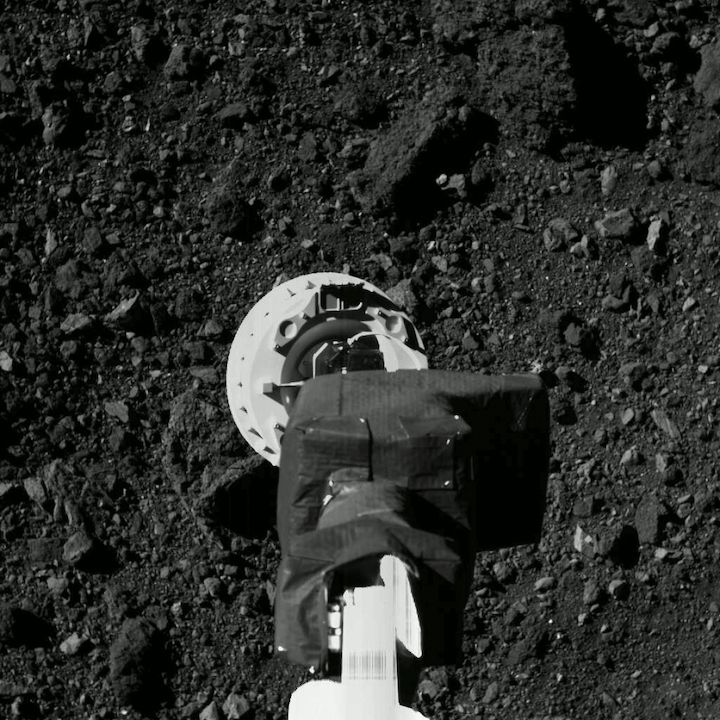
The University of Arizona-led OSIRIS-REx mission is poised to accomplish a first for NASA in planetary science: collect a sample from a near-Earth asteroid and bring it back home. The composition of the asteroid Bennu could shed more light on the origins and evolution of the 4.5 billion-year-old solar system.
On Oct. 20, the spacecraft will begin a flight trajectory to descend to the asteroid’s surface. Then, it will extend a sample collection arm that will briefly touch the surface, fire a small puff of compressed nitrogen to kick up debris and capture it before storing it in the body of the spacecraft for safekeeping on the two-year journey home.
Sept. 26 marks 25 days until the Touch-And-Go, or TAG, sample collection event, after which the spacecraft will stow the sample for its return to Earth on Sept. 24. 2023.
To celebrate the historic moment, UANews is counting down the 25 Days of "O-REx" with 25 facts.
25.
This mission is a first for NASA. Several NASA spacecraft have studied asteroids from a distance, but none have touched an asteroid and returned with material. The mission was designed to return at least 60 grams (slightly over 2 ounces) of pristine asteroid material to Earth for analysis.
24.

While scientists had predicted the asteroid's shape with uncanny accuracy, the surface of Bennu was unexpectedly rocky. The mission team spent over 18 months extensively surveying the surface for a boulder-free area before identifying Nightingale as the primary sample collection site and Osprey as the backup sample site.
23.
The primary sample site, Nightingale, is located in a crater in Bennu's northern hemisphere and was determined to be the safest spot for the Touch-And-Go sample collection maneuver. For scale, the spacecraft's brief touchdown will be like parking a shuttle van in an area about as wide as three parking spaces. The site is one-tenth as large as the original mission plan envisioned.
22.
On the journey back to Earth, the spacecraft will eject its sample return capsule containing the bits of Bennu for landing in the Utah desert on Sept. 24, 2023. The entire trip from launch to landing will have spanned seven years and 4.4 billion miles of space travel.
21.
The asteroid is a time capsule from the early solar system. Made from the crumbs of what was left over after the formation of the solar system, it is rich with organic compounds that may have seeded life on Earth.
20.
Bennu is about the same size as Pusch Ridge in the Santa Catalina Mountains, measuring about 500 meters, or about one-third of a mile, in diameter.
19.
The asteroid Bennu is a near-Earth asteroid – meaning it is not part of the main asteroid belt – and is situated between 241,000 and 209 million miles away, depending on its orbit relative to Earth's. Right now, the asteroid and spacecraft are about 200 million miles from Earth.
18.
Bennu is in an unstable orbit, meaning it likely won't last more than 10 million years before it collides with a planet or falls into the sun.
17.
Evidence of water was discovered locked within the clays that make up the asteroid. While Bennu itself is too small to have ever hosted liquid water, liquid water was likely present at some time on Bennu's parent body, a much larger asteroid.
16.
Bennu's temperatures range from 240 degrees Fahrenheit during the day to 100 below zero at night.
15.
The mission marked a milestone recognized by the Guinness World Records. The spacecraft made the closest orbit of a planetary body and made the asteroid the smallest planetary object ever orbited by a spacecraft.
14.
Bennu is shedding. It regularly ejects particles from its surface, highlighting just how dynamic the miniature world can be.
13.

The OSIRIS-REx mission's science team, headquartered at UArizona, created the most detailed image of any body in the solar system with its global mosaic of the asteroid Bennu. The mosaic was created by stitching together 2,155 images at a scale of 2 inches per pixel. The map was used to choose the primary and secondary sample sites.
12.
When the spacecraft touches down for sampling, it will do so on autopilot due to the 18.5-minute time delay between Earth and the spacecraft.
11.
The UArizona-built PolyCam is so named because it is a master of all trades and the world's best zoom lens – it can be a microscope and a telescope, and anything in between. It captured OSIRIS-REx's first image of the asteroid, helped with mapping large boulders and rocks and is expected to microscopically scrutinize tiny rocks and pebbles on the surface to ensure that they are small enough for sample collection.
10.
UArizona also built the two other on-board cameras – MapCam, which was used to map the surface of the asteroid, and SamCam, which will record the entire sample collection event and verify that a sample was collected.
9.

The spacecraft can navigate the asteroid using what's called natural feature tracking. By comparing the surface features found within the high-resolution image catalog with the surface, the spacecraft can autonomously guide itself to the surface for sample collection.
8.
O-REx will perform a pirouette in space to weigh how much material was collected during the Touch-and-Go sample collection event.
7.
While flying through space, the OSIRIS-REx spacecraft navigates using the stars, similar to ocean-going explorers.
6.
Bits of the asteroid Vesta were recently found on Bennu.
5.
A total of 150 UArizona undergraduate and graduate students have worked on OSIRIS-REx. More than 30 alumni have been hired to join the mission as staff after graduating.
4.
The mission's economic impact on Arizona is around $230.5 million. Of that, approximately $173 million comes to Tucson.
3.
UArizona professor Dante Lauretta is the principal investigator of the OSIRIS-REx mission, a $1 billion project led by the University of Arizona. The mission's science operations command center is at the UArizona Lunar and Planetary Laboratory.
2.
OSIRIS-REx builds on the university's long legacy of successful planetary exploration. The university has been part of almost every major NASA planetary mission since they began. The most recent NASA missions include HiRISE (Alfred McEwen, principal investigator), Dawn Mission (Mark Sykes, co-investigator, and Shane Byrne, guest investigator); Juno Mission (William Hubbard, co-investigator); and the New Horizons Mission to Pluto (Veronica Bray, science team member). UArizona was the first public university to be awarded a principal investigator-led mission when it was chosen to lead the Phoenix Mars mission.
1.
The mission is officially named the Origins, Spectral Interpretation, Resource Identification, Security-Regolith Explorer. Osiris is the Egyptian god of the underworld and "rex" means king in Latin. The mission objectives to return asteroid samples and analyze them in lab around the world loosely matches the mythological story of Osiris, whose body was cut into pieces and sprinkled all over Egypt, marking the spread of agriculture.
Quelle: The University of Arizona
----
Update: 1.10.2020
.
OSIRIS-REx readies for sample collection, observes strange activity at asteroid Bennu
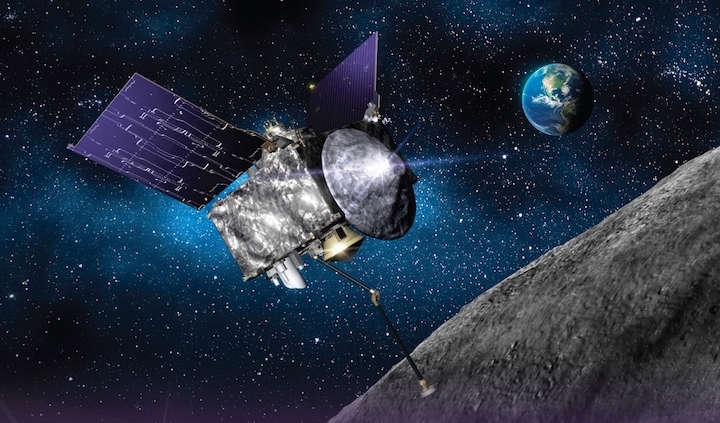
OSIRIS-REx — an international sample-return mission led by NASA and joined by science team members from Canada, France, Germany, the United Kingdom, and Italy, and with an instrument provided through the Canadian Space Agency — is less than one month away from performing a Touch-And-Go sample collection maneuver to return portions of asteroid Bennu to Earth.
Meanwhile, science teams have observed regular material shedding activity from the near Earth object — an unexpected find that allows scientists to better understand the dynamic little worlds littered throughout the inner solar system.
Ready for Touch-And-Go
Since arriving in orbit of Bennu on 31 December 2018, the NASA-led OSIRIS-REx mission has observed the near Earth object, asteroid Bennu, with a suite of scientific sensors and instruments, designed not just to study and transmit data about the asteroid back to Earth, but also to meticulously map its surface in high detail ahead of the Touch-And-Go (TAG) sample collection event, now scheduled for 20 October.
The TAG will see OSIRIS-REx fire its maneuvering thrusters for an Orbit Departure burn to lower its safe-home orbit of 770 m above Bennu’s surface down toward the asteroid’s surface.
During this initial phase of descent, the spacecraft will begin a sequence of reconfigurations to prepare itself for the sampling TAG. The first will see OSIRIS-REx extend its robotic sampling arm (the Touch-And-Go Sample Acquisition Mechanism — or TAGSAM) from its folded, stored position out to its sample collection position.
The spacecraft will then fold its solar panels into a y-wing configuration over its body – a maneuver that will both keep the arrays safely away from the asteroid’s surface while also repositioning the craft’s center of gravity directly over the TAGSAM collector head.
After this, OSIRIS-REx will reach a checkpoint position 125 m above Bennu’s surface. The craft will then perform the Checkpoint Maneuver burn to begin a steep but slow vertical descent that will bring it to a point 54 m above Bennu 11 minutes later.
Here, OSIRIS-REx will perform the Match Point burn to slow its descent and align its path to match the asteroid’s rotation at the time its onboard navigation system plans for it to contact the sampling location.

